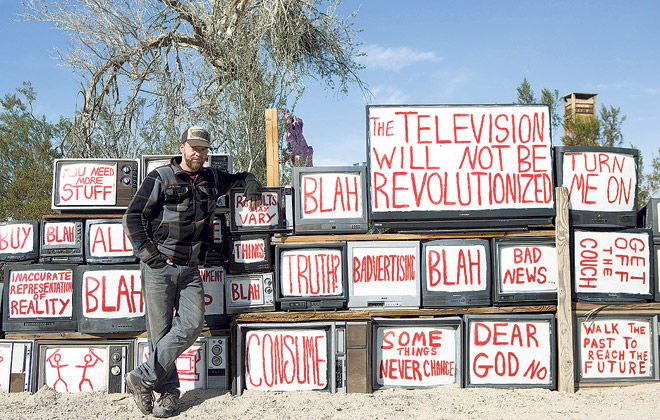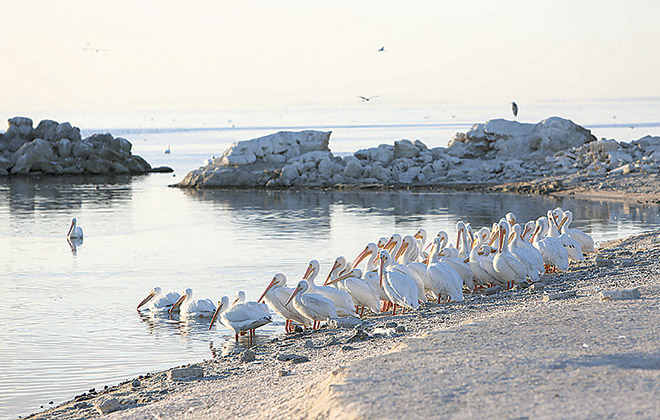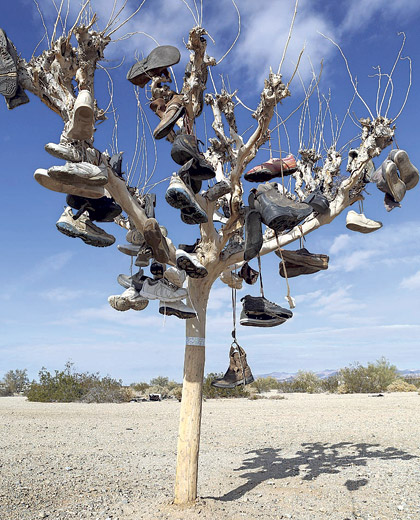California ruins attract adventure seekers

Flip Cassidy stands before his work “The Television Will Not Be Revolutionized” in East Jesus, an artist colony in Imperial County, Calif. East Jesus and Slab City, a nearby squatters camp, draw curiosity seekers looking for adventure far, far off the beaten path to this stretch of California’s remote southeastern desert.

Pelicans on the shore of the Salton Sea, once home to glittering resorts before excessive salinity killed countless fish and drove tourists away, in North Shore, Calif.

Shoes hang from a dead tree in Slab City, in the deep desert near Niland, Calif. Slab City is near Salton Sea, a large lake with high salinity.



California has always been linked with the idea of American possibility. It’s the sun-drenched place where you go to leave the stuffy, decaying old world for a new life. But not everything here is shiny, new and full of potential. Drive deep into the deserted corners of Southern California and you’ll find dreams that flickered to life briefly and then faded away. Places once destined for greatness that have disintegrated into modern ruins.
These long-forgotten places are being discovered anew by artists and curiosity seekers hungry for a post-apocalyptic getaway. I explored a few of them last summer. These desolate stretches supply a different sort of adventure, one that involves getting far off the beaten path, in some cases beyond the bounds of civilization.
SALTON SEA AND BEYOND
This "sea," about 2 1/2 hours east of Los Angeles, is a joint effort of man and nature. It became a body of water in 1905 when a stretch of the Colorado River flooded, crashing its canal gates and pouring into a depression downstream, well below sea level. At 45 miles long and 20 miles wide, it’s now the largest lake in the state.
Despite its size, it wasn’t a draw until the 1960s, when air conditioning made the idea of building accommodations in the stifling region less unthinkable. Almost overnight the sea became a popular vacation destination, and developers saw it as the "Desert Lake Tahoe" and "Palm Springs on the Beach." They built hotels, marinas and yacht clubs all over its shores, drawing celebrities like Frank Sinatra and families alike.
Then things started to go very wrong. Since the sea had no natural aquifers, its high salt levels, combined with agricultural runoff, only got higher. Algae started to take over, and fish began dying in huge numbers. Their fetid, rotting carcasses were enough to send the glamorous set fleeing. The sea was swiftly deserted.
Don't miss out on what's happening!
Stay in touch with breaking news, as it happens, conveniently in your email inbox. It's FREE!
Now it is a time capsule of what might have been. But my traveling companions and I were still able to take in the mystery, majesty and horror of the sea around it. When you walk to the water, the panorama surrounding you is impressive — the mountains rising out of the water amid a backdrop of emptiness. Then you get your first whiff of salt and rot, and your first look at the dead fish lapping up on the shore. Kneel down and get a closer look at the sand, and you realize that it’s not sand at all. It’s tiny crushed fish bones. This is not your average sunny California destination.
CALIFORNIA CITY
This destination — or nondestination — was dreamed up in the 1960s by Nat Mendelsohn, an ambitious developer who wanted to make it the third-largest municipality in the state, after Los Angeles and San Francisco. It seemingly had all the makings of a great new city: It was in what was then a burgeoning aerospace center (Edwards Air Force Base is nearby), two hours north of Los Angeles in the Mojave Desert.
The glimmering mountains to the east — Death Valley is just on the other side — are majestic, and the huge sun exerts its impressive dominance, but the dust is constant and the poverty is real. The residents here are not well off; many live in ramshackle houses and trailers.
Yet being here you get to undertake a rare, phenomenal urban journey: the search for nothingness. If you want to get to know solitude, this is the right place. It’s a vacuum of time and space.
SUNKEN CITY
On the southernmost tip of San Pedro, the home of Los Angeles’ port, this was once a promising cliffside housing development overlooking the ocean. But in 1929 the entire thing was sent shifting into the ocean after a series of landslides. The situation worsened quickly until the whole area was abandoned.
The "city" is technically closed to the public, as is made clear by the "No Trespassing" sign on the gate. But when I was there, there were more than 100 people visiting the site, strolling, having picnics and playing guitars, all in clear view of the adjacent park.
There’s at first not too much to see besides a sheer oceanfront cliff to your right and an empty expanse in front of you. But walk about 100 feet forward and you look over a ledge into the city. It’s as if the ground dropped out from under you, as in one of those Hollywood earthquake scenes. Far below is a dispersed mass of broken concrete slabs, covered with graffiti and woven with dirt paths. It’s a fantasy drip castle that’s much less wholesome. A climbable, natural art park.
Like the other stops, Sunken City seems like an escape from reality. There are no tour guides or special vacation packages. You’re more or less on your own.
It makes you wonder whether anything is permanent. As you wend your way back to civilization — and Los Angeles traffic — it is a thought that you’ll want to hold onto.
Sam Lubell, New York Times
© 2014 The New York Times Company




